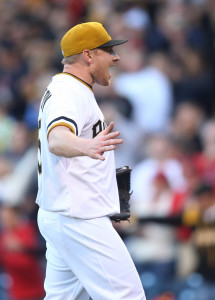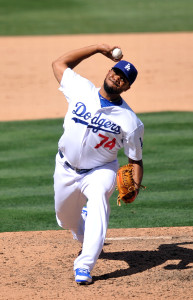Dodgers closer Kenley Jansen won’t discuss an extension during the season, which means he’s highly likely to test free agency next winter, Bill Shaikin of the Los Angeles Times writes. Jansen says there are currently no discussions between the two sides. “I’m not going to talk about it,” he says. “I’ll just want to talk about that in October.” The Dodgers reportedly did not discuss a long-term contract with Jansen while they were reaching their arbitration-avoiding $10.65MM deal with him in January. As MLBTR’s Mark Polishuk pointed out at the time, top Dodgers exec Andrew Friedman tended to focus on cheaper relief pitching when he was with the Rays. The Dodgers do, however, have a much bigger budget, despite their relatively thrifty offseason, and their interest in Aroldis Chapman before revelations of his domestic violence issue this past winter perhaps indicates somewhat of a willingness to pay heavily for a top reliever. Jansen certainly fits into the “top reliever” category, given his 2.41 ERA with a spectacular 13.8 K/9 and 1.4 BB/9 last year and his long track record of success. Here’s more from the National League.
- The Colorado Springs Sky Sox, currently the Brewers’ Triple-A affiliate, will soon meet with San Antonio’s city council to discuss potential plans to move the franchise there, Brent Briggeman of the Colorado Springs Gazette writes. “If the City of San Antonio, the 37th largest TV market in the country, calls and says they would like to talk about a downtown stadium and the possibility of bringing Triple-A Baseball to San Antonio, it would be imprudent as business owners not to listen,” say the Sky Sox in a statement. The move would, apparently, be contingent upon San Antonio building a downtown ballpark appropriate for Triple-A baseball. The Elmore Sports Group, which owns the Sky Sox, also owns the Double-A San Antonio Missions, currently a Padres affiliate. The Sky Sox have been in Colorado Springs for nearly three decades, serving as the Rockies’ longtime Triple-A home most of that time before a recent switch to the Brewers.
- Braves manager Fredi Gonzalez expresses concern about the team’s bullpen in a three-part Q+A with the Atlanta Journal-Constitution’s David O’Brien (1, 2, 3). Gonzalez expresses confidence in the ability of both Arodys Vizcaino and Jason Grilli to close, and expresses a level of comfort with veterans Jim Johnson and Eric O’Flaherty. He does, however, hope that the team can improve its performance in the middle innings this season. Gonzalez says he doesn’t feel any more pressure than usual given that this will be the Braves’ last season in Turner Field before moving into a new ballpark next year. “I think you can do both – I think you can develop [young players] and I think you can win games,” he says. “I’m not going to say we’re going to go out and win 110 games or any of that crazy stuff, but as far as pressure I don’t feel any different from any other year.”


